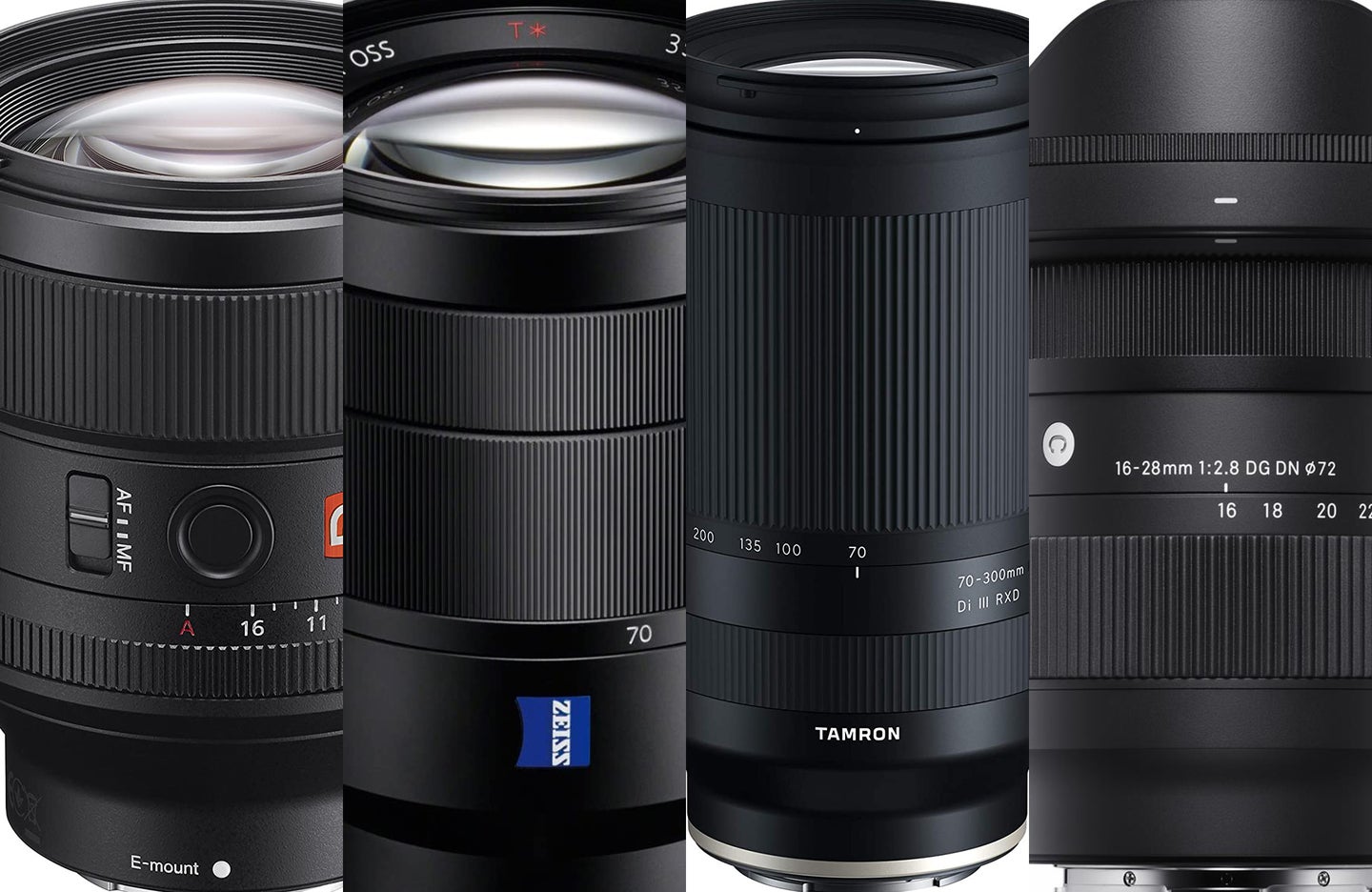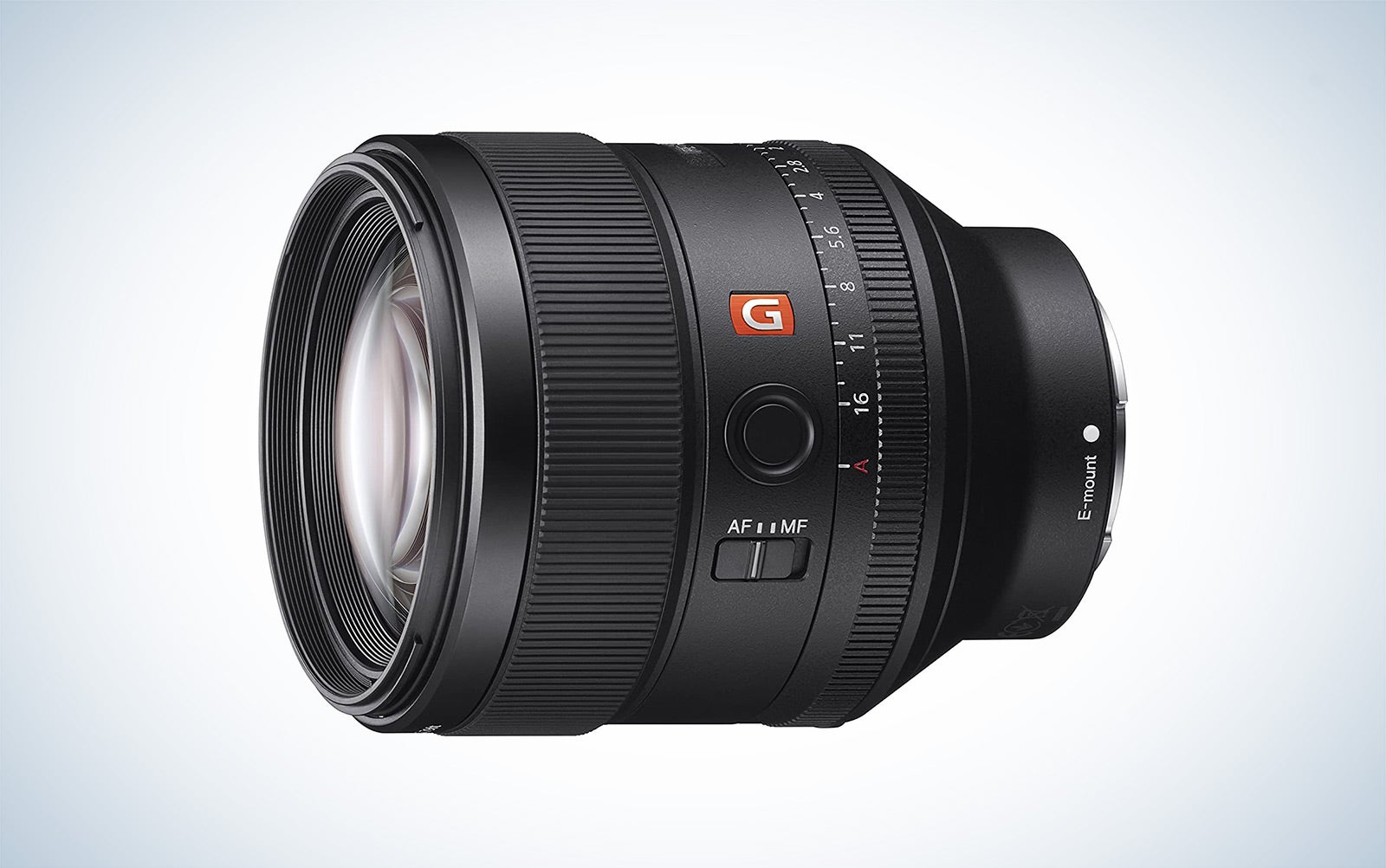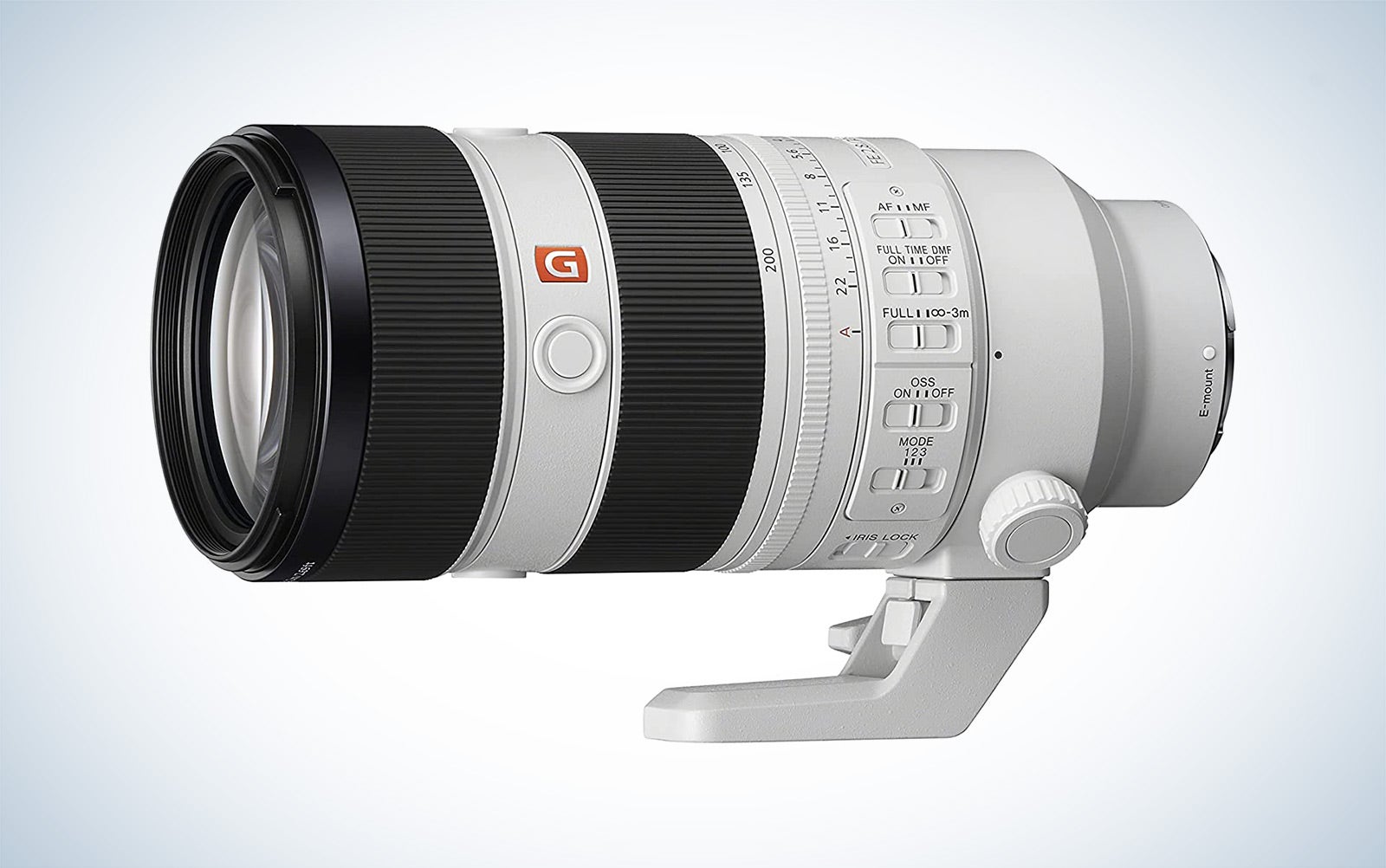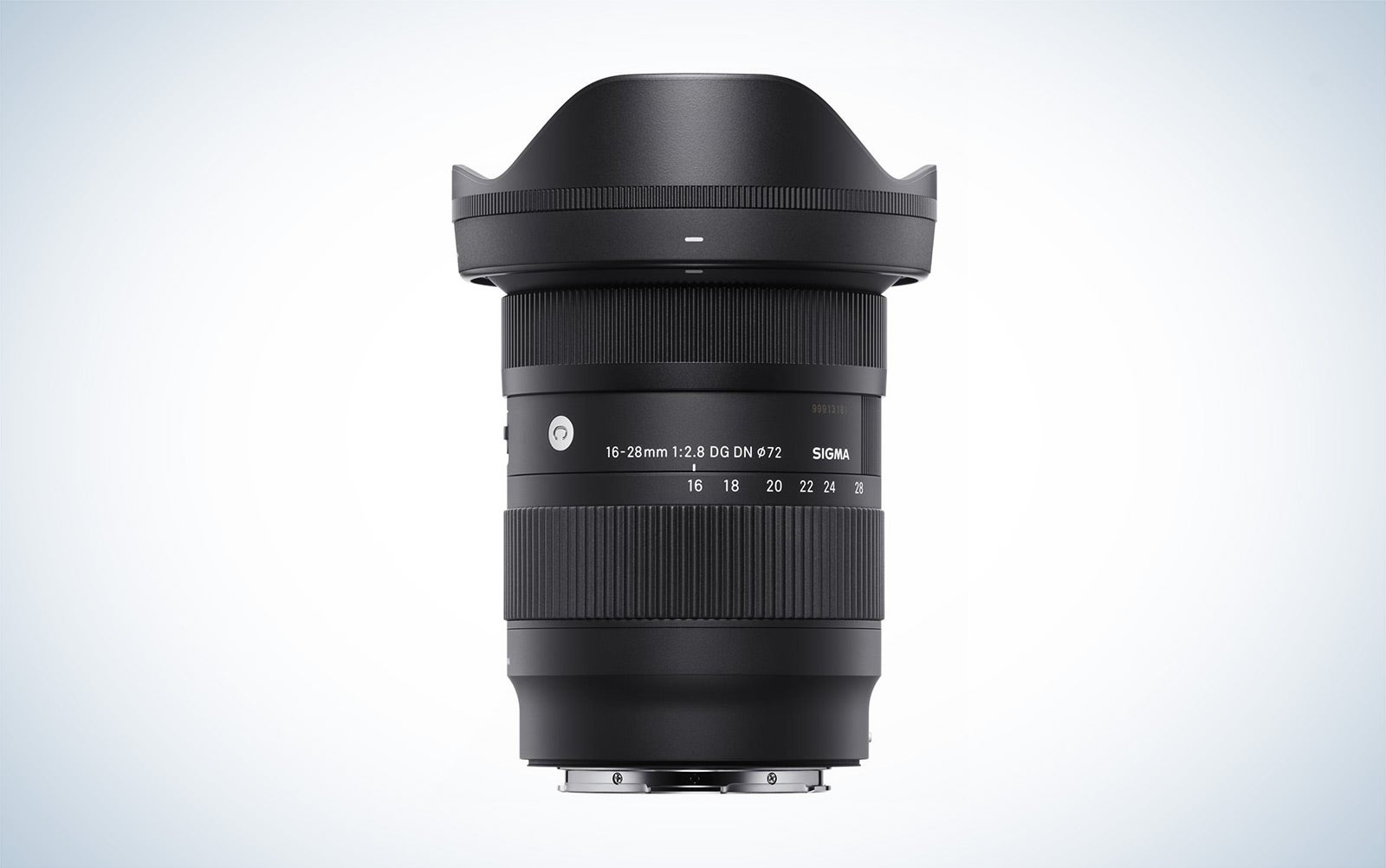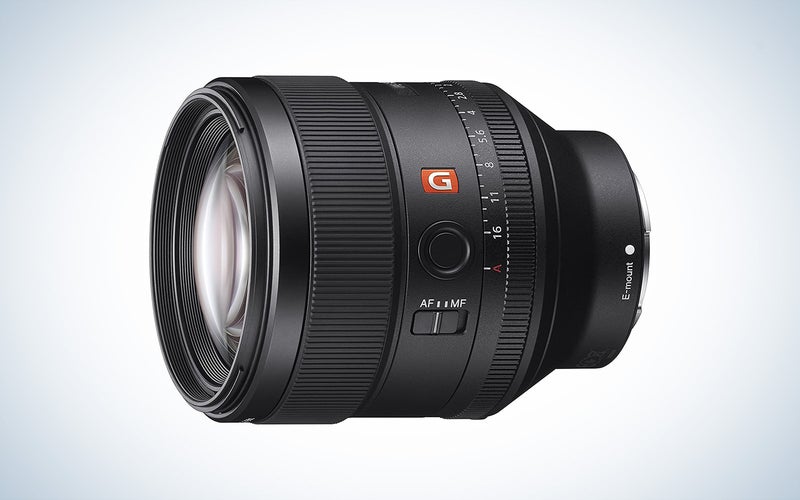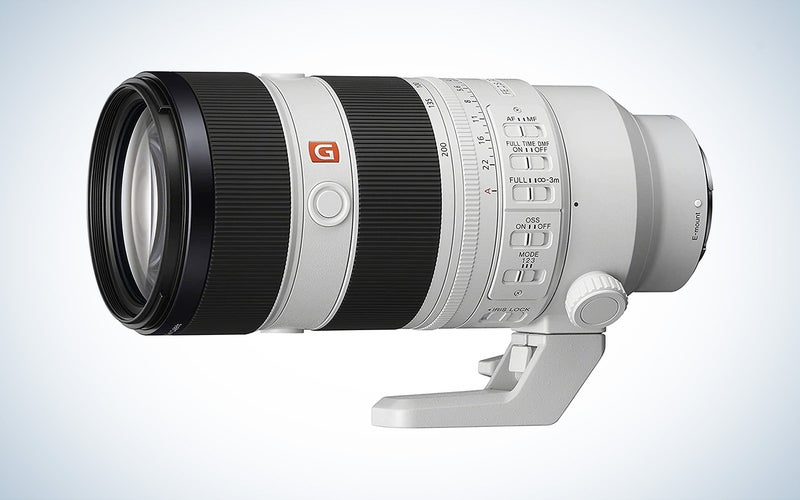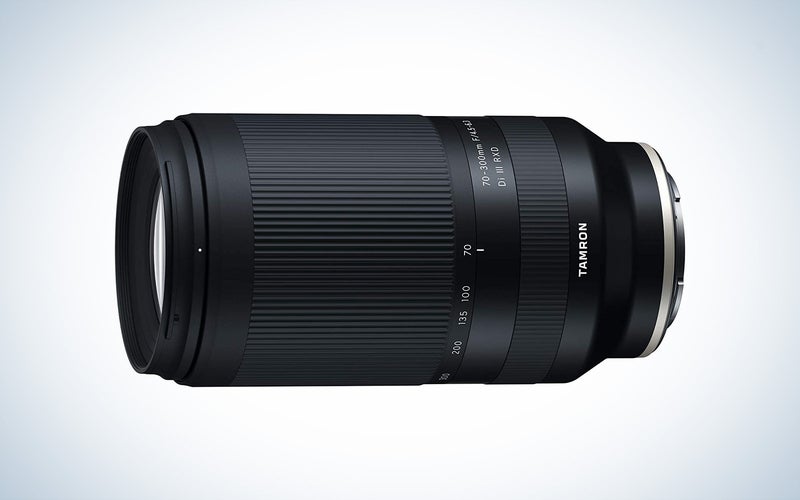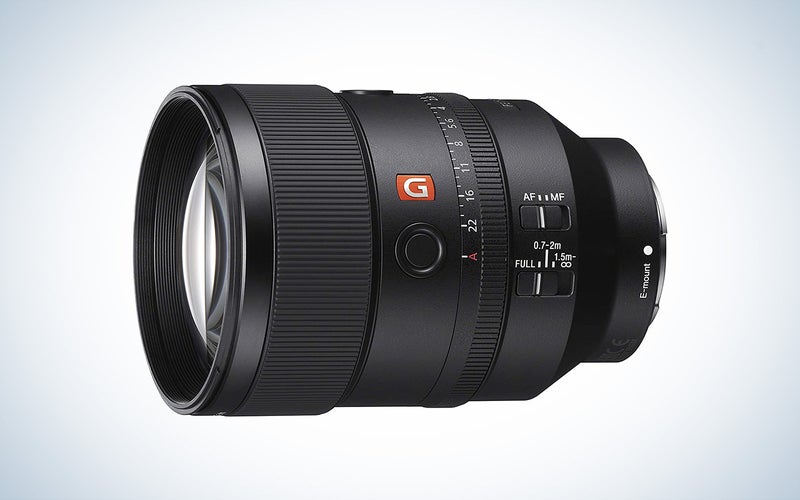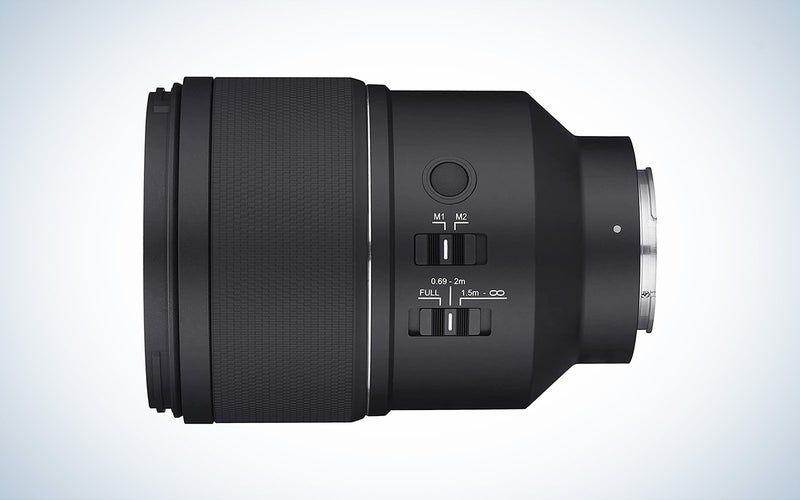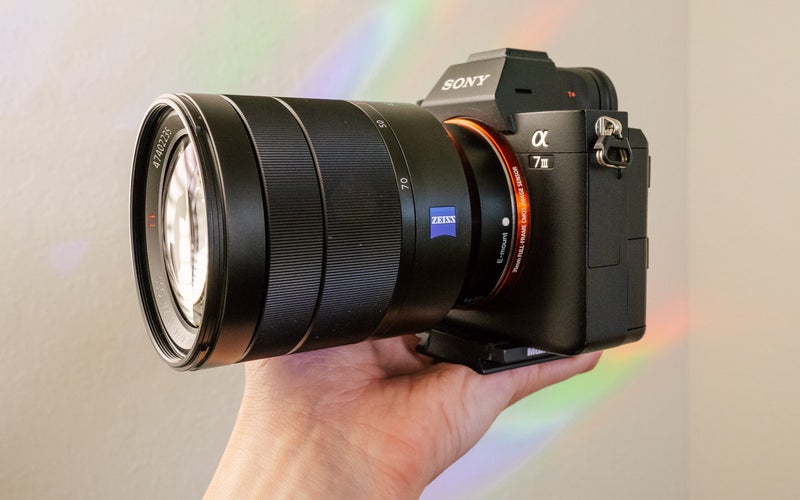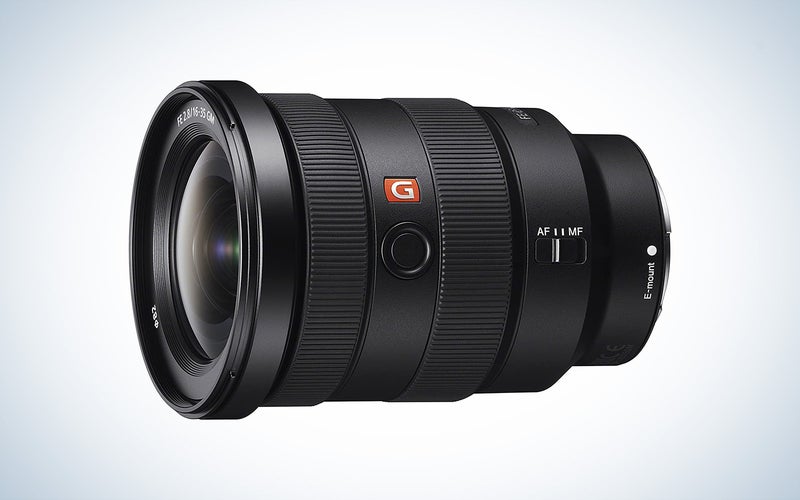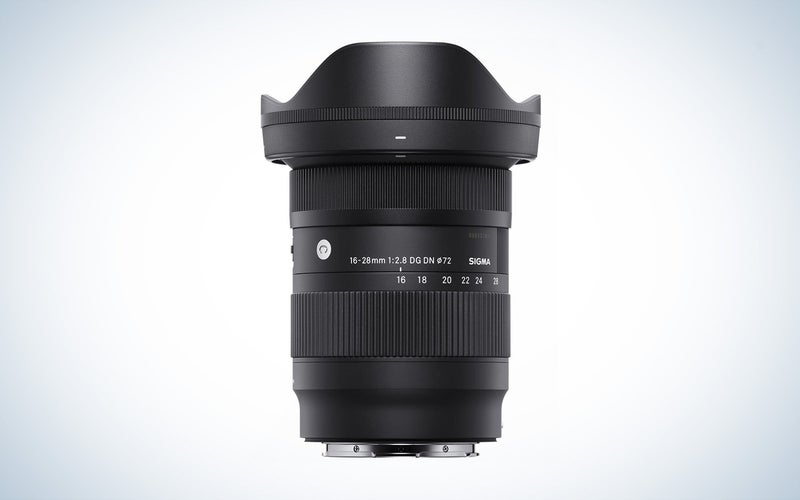We may earn revenue from the products available on this page and participate in affiliate programs. Learn more ›
The right portrait lens for Sony cameras can help you take your portrait photos to the next level. Portrait photography is a challenging genre that requires serious skill. You need to establish a relationship with your subject, choose the most flattering light, and nail that perfect eye focus. Choose the wrong lens, though, and none of that matters. If you’re seeking a Sony lens for portraits, it’s easy to hone in on the G Master glass. It’s undeniably beautiful, but it’s also big and expensive.
Third-party lenses (lenses that are created by companies that aren’t Sony) can help you save money, but they may not be able to utilize your Sony camera’s image stabilization and autofocus capabilities in the same way that a lens made by Sony will. A little bit of research will go a long way in getting you one of the best portrait lenses for Sony cameras for your style.
- Best overall: Sony FE 85mm f/1.4 GM Lens
- Best zoom: Sony FE 70-200mm f/2.8 GM OSS II
- Best budget zoom: Tamron 70-300mm f/4.5-6.3 Di III RXD Lens
- Best prime: Sony FE 135mm F1.8 G Master Telephoto Prime Lens
- Best budget prime: Samyang AF 135mm f/1.8 FE Lens
- Best for beginners: Sony Vario-Tessar T* FE 24-70mm f/4 Lens
- Best wide-angle: Sony FE 16-35mm f/2.8 GM Lens
- Best budget wide-angle: Sigma 16-28mm f/2.8 DG DN Contemporary Lens
How we picked the best portrait lenses for Sony
The writers and editors at PopPhoto have decades of experience in just about every genre of photography and with every major camera brand. We used this knowledge to assess lenses for Sony cameras that would be ideal for various types of portraiture. In making our selections, we considered overall lens quality, including sharpness, bokeh quality, distortion, and aberrations. We also evaluated various lens features like image stabilization and weather-sealing. Lastly, we aimed to find lenses at various price points suitable for different budgets and experience levels.
The best portrait lenses for Sony: Reviews & recommendations
Best overall: Sony FE 85mm f/1.4 GM Lens
Sony
Why it made the cut: Sony’s 85mm GM lens is a spectacular take on this classic portrait focal length, offering exceptional sharpness and beautiful bokeh.
Specs
- Lens mount: Sony E (full-frame)
- Aperture range: f/1.4 – f/16
- Image stabilization: No
- Filter size: 77mm
- Minimum focus distance: 2.62 feet
- Weight: 1.8 pounds
- Dimensions: 3.52 x 4.23 inches
Pros
- Stunning image quality
- Rugged build quality
- Includes a physical aperture ring
- Fast and bright f/1.4 aperture
Cons
- No stabilization
An 85mm prime is generally regarded as the best lens for shooting portraits because of how it flatters your subjects. This Sony G Master 85mm is one of our favorite portrait lenses for Sony because it was designed to offer ultimate resolution and beautiful bokeh. It provides a fast maximum aperture of f/1.4, which is ideal for low-light situations. That and the 11-blade circular aperture found inside the lens will help you create portrait photos with tack-sharp subjects and beautifully defocused backgrounds.
Sonys 85mm GM is made up of one XA element, three ED elements, and a Nono AR coating. These help to improve clarity, color, and contrast, even in tricky lighting conditions like backlighting. And it’s dust and moisture-resistant to give you more confidence using it outside.
The lens utilizes Sony’s Linear Super Sonic wave Motor (SSM) to maximize autofocus speed and precision. It pairs well with the impressive autofocus systems found in Sony’s cameras. And you can de-click the physical aperture ring for silent and smooth aperture changes when recording video. It’s a well-rounded lens that offers the highest level of quality.
Best zoom: Sony FE 70-200mm f/2.8 GM OSS II
Sony
Why it made the cut: Sony’s G Master telephoto zoom offers a versatile zoom range, a bright and constant maximum aperture, and of course, exceptional sharpness. It’s also quite lightweight for a lens of this focal length range.
Specs
- Lens mount: Sony E (full-frame)
- Aperture range: f/2.8 – f/22
- Image stabilization: Yes
- Filter size: 77mm
- Minimum focus distance: 1.3 feet
- Weight: 2.3 pounds
- Dimensions: 3.46 x 7.87 inches
Pros
- Lightweight for this lens class
- Fast, bright, and constant max f/2.8 aperture
- Dust- and splash-resistant design
- Extremely sharp
Cons
- Expensive
This is the second iteration of Sony’s 70-200mm, which offers noticeable improvements over the first. The most significant is that it weighs 2.3 pounds, which is 29 percent lighter than the first version. It’s one of the lightest lenses of this focal length range across brands, making it easier to carry around at a wedding or other day of shooting.
The weight savings is in part thanks to a new optical formula, which also improves image quality. The lens now features two ED (extra-low dispersion), two Super ED elements, including one aspherical ED element, and two aspherical lenses, all of which reduce aberrations and improve clarity. And it works. Images from this lens are extremely sharp and clear, making it a top choice for pros seeking a portrait lens for Sony.
Sony also implemented a new autofocus system in the second version, resulting in much faster focusing. Sony has prioritized video in recent years and managed to make this lens an excellent hybrid lens. It reduced focus breathing and focus shifting for better video results. The lens also features a physical aperture ring which you can de-click for video applications as well.
While we think the improvements in the second version are well worth the money, the original 70-200mm GM is still a fantastic lens and will save you some money.
Best budget zoom: Tamron 70-300mm f/4.5-6.3 Di III RXD Lens
Tamron
Why it made the cut: Tamron managed to make an ultra-telephoto zoom lens at an affordable price with a surprisingly compact body, fast autofocus, and great image quality.
Specs
- Lens mount: Sony E (full-frame)
- Aperture range: f/4.5 to 6.3 – f/22 to 32
- Image stabilization: No
- Filter size: 67mm
- Minimum focus distance: 2.6 feet
- Weight: 1.2 pounds
- Dimensions: 5.8 x 3 inches
Pros
- Very versatile zoom range
- Extremely compact and lightweight
- Extremely affordable
Cons
- No stabilization
Telephoto zoom lenses with long reach typically get quite expensive and bulky. And yet, third-party optics company Tamron created an ultra-telephoto zoom with a highly versatile 70-300mm range that comes in under $600 and weighs more than a pound less than the Sony 70-200mm GM lens.
Tamron’s 70-300mm offers a lot of quality for the price. The lens body is weather-sealed, which you typically only get on higher-end lenses. Its autofocus is fast and nearly silent and works with Sony’s advanced autofocus features like subject tracking and eye detection. And the lens is surprisingly sharp in the center with limited aberrations. There is some edge softness, but it gets better as you zoom in.
Of course, the low price comes with some compromises. Most notable is the rather slow aperture that varies from f/4.5 to f/6.3 as you zoom in. And there isn’t any stabilization or vibration control in the lens. That won’t be as big of a deal for those with newer Sony a7 series cameras, which have five-axis stabilization. But without that, you’ll need to bump your ISO up pretty high in order to get blur-free images. All in all, the Tamron 70-300mm offers a lot of value despite these few downsides, making it one of our favorite portrait lenses for Sony cameras.
Best prime: Sony FE 135mm F1.8 G Master Telephoto Prime Lens
Sony
Why it made the cut: Sony’s 135mm GM lens offers exceptional sharpness, a fast f/1.8 aperture, and lightning-fast autofocus.
Specs
- Lens mount: Sony E (full-frame)
- Aperture range: f/1.8 – f/22
- Image stabilization: No
- Filter size: 82 mm
- Minimum focus distance: 2.3 feet
- Weight: 2 pounds
- Dimensions: 3.52 x 5 inches
Pros
- Stunning bokeh
- Exceptionally sharp
- Rugged weather-sealed construction
- Fast f/1.8 aperture
Cons
- Pricey
Think of the 135mm G Master lens as the older sibling of the 85mm G Master. Telephoto primes are great for shooting portraits because of the flattering perspective that flattens everything out and the background separation that is possible. That is especially true with the 135mm GM, which features an 11-blade circular aperture for beautiful bokeh, especially if you are shooting wide open at f/1.8.
This G Master lens is known for its extraordinary sharpness. The lens is made up of XA, Super ED, and ED elements for high-resolution images edge to edge. But where it really shines is with autofocus. The lens utilizes an XD Linear Motor system and internal focus mechanism for accurate and quiet autofocus. It’s also extremely fast to focus, making this lens a great choice for sports or action.
Though 135mm is slightly less flexible than 85mm, the extra length makes it handy for things like wedding ceremonies where you can’t get as close or portraits in busy settings where you want to cut through distracting elements in the foreground. It offers a focus limiter and manual focus switch, as well as an aperture ring that can be de-clicked for video use. There are also two programmable buttons to make your shooting process more streamlined. It’s a pricey lens, but it is one of the best high-end Sony portrait lenses.
Best budget prime: Samyang AF 135mm f/1.8 FE Lens
Samyang
Why it made the cut: Samyang’s 135mm for Sony E mount rivals Sony’s GM version in sharpness and offers the same bright f/1.8 aperture but comes at a fraction of the price.
Specs
- Lens mount: Sony E (full-frame)
- Aperture range: f/1.8 – f/22
- Image stabilization: No
- Filter size: 82mm
- Minimum focus distance: 2.2 feet
- Weight: 1.7 pounds
- Dimensions: 3.7 x 5.1 inches
Pros
- Very sharp
- Affordable
- Weather-sealed
- Customizable controls
Cons
- No stabilization
Samyang is commonly overlooked, though the company has produced impressive lenses, especially in recent years. Its 135mm for Sony E mount is one such example. It is an extremely sharp lens, rivaling the powerhouse Sony 135mm GM lens. The lens is sharp across the entire frame, even when shooting wide open. It also features a fast f/1.8 aperture and 11-blade aperture diaphragm, like the Sony. As a result, it provides beautiful bokeh.
The lens is surprisingly customizable, so you can tailor things to how you shoot. One such control is a switch that allows you to use the focus ring as an aperture control, which the lens doesn’t have. You can also program the focus hold button as you wish. Some changes require the Samyang Lens Station, while some can be done in Sony’s menus.
The lens’s autofocus is fast and quiet, but it cannot match the performance of the Sony. It won’t be as suited for action as a result. But you can still use all of Sony’s advanced autofocus features with the Samyang, so it isn’t anything to sneeze at. The Samyang lens is also weather-sealed and fairly rugged and weighs slightly less than the Sony. All of this, and it’s less than half the price of the Sony GM. It’s a truly excellent portrait lens for Sony, especially given the price.
Best for beginners: Sony Vario-Tessar T* FE 24-70mm f/4 Lens
Abby Ferguson
Why it made the cut: This classic standard zoom offers a bit of everything (wide, normal, telephoto) with fast autofocus in a rugged, compact, and affordable body.
Specs
- Lens mount: Sony E (full-frame)
- Aperture range: f/4 – f/22
- Image stabilization: Yes
- Filter size: 67mm
- Minimum focus distance: 1.3 feet
- Weight: 15.03 ounces
- Dimensions: 2.87 x 3.72 inches, 4.9 inches at maximum extension
Pros
- Affordable
- Versatile zoom range
- Durable build quality
- Includes stabilization
Cons
- Not very sharp zoomed out
We’d suggest everyone have a 24-70mm lens in their kit because of its versatility, but that’s especially true for beginners. You get a bit of a wide angle, normal, and telephoto all in one body, so you won’t have to change lenses as frequently. That also means don’t need to own a bunch of lenses as you are getting started. For portraits specifically, you can get some flattering telephoto portraits and take environmental portraits with the same lens.
Sony’s Carl Zeiss-branded lens is a fantastic entry-level or enthusiast lens thanks partly to the reasonable price. Though the f/4 maximum aperture isn’t blazing fast, it is constant throughout the zoom range and still allows you to get some nice bokeh, especially when zoomed in. In addition, the lens features ZEISS T* anti-reflective coatings, which result in excellent clarity, contrast, and colors. And it’s dust- and moisture-sealed and offers tough metal construction for exceptional durability. Speaking from experience, this lens can take some hits and be just fine.
Unfortunately, this Sony portrait lens shows some rather significant softness in the corners at either end of the focal length range. Sharpness improves in the middle focal lengths, however. It won’t provide the same high-resolution results as Sony’s 24-70mm GM, but it does offer a lot of value considering the price.
Best wide-angle: Sony FE 16-35mm f/2.8 GM Lens
Sony
Why it made the cut: This wide-angle lens makes unique environmental portraits possible with a versatile 16-35mm range while providing a fast f/2.8 aperture. It’s also sharper than any other wide-angle zoom available.
Specs
- Lens mount: Sony E (full-frame)
- Aperture range: f/2.8 – f/22
- Image stabilization: No
- Filter size: 82mm
- Minimum focus distance: 11 inches
- Weight: 1.5 pounds
- Dimensions: 3.5 x 4.8 inches, 5.4 inches at maximum extension
Pros
- Fast f/2.8 max aperture
- Extremely sharp
- Durable build
- Attractive bokeh
Cons
- Expensive
Although a wide-angle lens isn’t the most common choice for portraiture, there are times this focal length is the best choice. Whether you’re shooting group photos at a wedding or capturing the scenery behind a skier, a wide-angle can provide a unique perspective and help you show more. Sony’s 16-35mm GM is the sharpest wide-angle zoom across all brands, making it a top choice for a wide-angle Sony portrait lens.
On top of being exceptionally sharp across the entire frame, even when wide open, the lens also offers a bright f/2.8 max aperture. This is ideal for low-light shooting, such as wedding receptions, but it also makes a shallow depth of field with nice bokeh possible. It can focus as close as 11 inches, and while it won’t offer the magnification of a macro lens, it can result in some unique closeups.
As with all Sony G Master lenses, autofocus is quick and accurate. And the body is weather-sealed for greater durability. As we would expect on a lens this wide, there is some distortion, but it’s very easy to remove automatically, either in camera or in post.
Best budget wide-angle: Sigma 16-28mm f/2.8 DG DN Contemporary
Sigma
Why it made the cut: Sigma’s 16-28mm is lighter than Sony’s 16-35mm, features all internal zoom, and is extremely sharp. And yet, it’s relatively affordable.
Specs
- Lens mount: Sony E (full-frame)
- Aperture range: f/2.8 – f/22
- Image stabilization: No
- Filter size: 72mm
- Minimum focus distance: 9.8 inches
- Weight: 15.9 ounces
- Dimensions: 3 x 4 inches
Pros
- Internal zoom is ideal for use on gimbals
- Very sharp
- Affordable
- Lightweight and compact
Cons
- Less range than the Sony equivalent
Sigma’s wide-angle zoom offering for Sony E-mount is a fantastic lens. Of course, it doesn’t provide quite the reach of the Sony 16-35mm, which is a bummer. But we think it’s still a great option for portraiture nonetheless. The 16-28mm is perfect for getting ready shots, group photos, or reception images at weddings, as well as adventure portraits or even dramatic street photography.
Sigma’s 16-28mm features all internal zoom, which makes it much easier to use on gimbals, as you won’t have to worry about rebalancing. It’s relatively lightweight and compact, making it easier to carry around. And the autofocus is fast, quiet, and accurate, so it can easily handle some action shots of a snowboarder blowing past you.
On top of all that, this lens is also very sharp. It has great edge-to-edge sharpness even when wide open, meaning you can take full advantage of that fast f/2.8 aperture. Sigma applied Super Multi-Layer and Nano Porous coatings to reduce lens flares and improve contrast, so you’ll get great image quality even when the sun is in the frame. Overall it offers a lot of quality for the price for both video and photo applications. But if you want something more dramatic and don’t mind spending a bit more, the Sigma 14-24mm f/2.8 DG DN ART lens is one of my favorites.
More portrait lenses for Sony that we love:
For smooth backgrounds: Sony FE 100mm f/2.8 STF GM OSS Lens
Sony’s 100mm utilizes a unique design that results in incredibly smooth backgrounds. Sony utilized an apodization (APD) element that allows for what Sony has dubbed Smooth Trans Focus. Essentially, the APD element allows for smoother, more circular bokeh for buttery soft backgrounds.
Budget zoom: Sony 18-105mm F4 G OSS
This 18-105mm lens features a widely versatile zoom range, and yet it is relatively compact and lightweight (15.1 ounces and 4.3 inches long). Because of that, it’s a great travel portrait lens, as you won’t mind keeping it on you. It’s also quite affordable for what you get, making it an excellent option if you are just getting started with photography.
Budget wide-angle prime lens: Tamron 35mm f/2.8 Di III
Shooting portraits with a 35mm prime is a classic length favored by photojournalists. This f/2.8 lens has a close focusing distance of 5.9 inches and features a dirt-resistant fluorine coating on the front element. It only weighs 7.4 ounces, so it won’t weigh you down while you are shooting. It’s also one of the cheapest lenses you can get for taking portraits on your Sony camera.
High-end standard zoom: Sony FE 24-70 mm F2.8 G Master II
You can’t beat Sony’s take on the classic 24-70mm lens. The lens provides a fast f/2.8 max aperture, perfect for low-light conditions. It offers exceptional image quality, lightning-fast autofocus, and attractive bokeh. It’s also weather-sealed and features a rugged build.
Bokeh monster: Sigma 105mm f/1.4 DG HSM Art
You don’t typically see a super-wide f/1.4 aperture on a lens this long. Shoot wide open, and it will create a super-narrow band of focus that can separate a subject from a cluttered background. That wide aperture also lets in tons of light, which means it’s great for low-light situations.
Ultra-fast ultra-wide: Sony FE 12-24mm f/2.8 GM
If you want something more dramatic than the Sony 16-35mm, the 12-24mm f/2.8 GM is the top choice. It’s beautifully sharp, is capable of attractive bokeh, and provides a unique perspective thanks to the ultra-wide focal length. And, like all G Master lenses, it’s weather-sealed and offers incredibly fast autofocus.
Things to consider when shopping for a portrait lens for Sony
APS-C or full-frame lens
When selecting a portrait lens for your Sony camera, it’s important to understand that Sony makes cameras with two different sensor sizes: Full-frame and APS-C (a smaller sensor, also called crop sensor). Sony specifically designed lenses for each type of sensor, but because all Sony cameras utilize the E-mount regardless of sensor size, you can use any lens on any camera.
That said, the lenses designed for smaller APS-C cameras—such as the a6400—don’t create an image big enough to cover a full-frame sensor. This results in a black circle around the image unless you go into your settings and ask the camera to crop in. And then you are losing out on parts of the image, which generally isn’t ideal. Of course, APS-C lenses are smaller and more affordable, so depending on your priorities, it may still be worth dealing with the crop.
The lenses that we’ve selected here are all full-frame lenses, but as mentioned, can be used on APS-C cameras. The important thing to know is that crop factor comes into play when using any lens on a crop sensor camera. With Sony cameras, there is a 1.5x crop factor, meaning you’ll need to multiply the focal length by 1.5 to determine how the focal length will actually appear on your APS-C camera. So, for example, an 85mm lens on an APS-C will behave like roughly a 127mm lens.
Zoom versus prime lens
When selecting a portrait lens for Sony cameras, the first decision you’ll make is between a fixed-focal-length lens or a zoom lens. Fixed-focal-length lenses (also known as prime lenses) typically offer wider apertures than zoom lenses, making them a great choice for shooting in low light. That feature also allows shooters to create portrait photographs that are extremely sharp on the subject with a lovely defocused background. Prime lenses can also offer more quality at a lower price, but given you are just getting one focal length, it lacks the versatility of a zoom lens.
A zoom lens is a more versatile option for shooting portraits since they offer a range of focal lengths in one lens body. A 24-70mm lens or a longer telephoto lens are both handy tools to have in your kit. These lenses can be particularly useful when shooting portraits at an event. A long telephoto zoom lens will provide the same flattering perspective as an 85mm prime, while a shorter 24-70mm lens can make it easier to flip between portraits and event details without having to carry a second Sony camera body or swap lenses constantly.
Focal length
Both prime and zoom lenses come in a variety of focal lengths, but 85mm is the most classic portrait option. A lens with this focal length allows the photographer to be farther from their subject and capture a headshot-style portrait or a full-body portrait without adding distortion to the image. It’s popular with portrait photographers because of its flattering perspective. Longer lenses can result in more dramatic background blur, but you will have to stand further away from your subject, which may not be ideal.
Some shooters prefer shorter lenses in the 50mm or 35mm range. These focal lengths are a great option for capturing environmental portrait photos because of their slightly wider field of view. Most portrait photographers avoid going any wider, as a wider angle portrait will start to add distortion to the features of your subject. But some situations, such as large group photos at weddings or dramatic environmental portraits, may call for something wider. Just be aware that it will introduce some distortion, so ultra-wide won’t be suitable for most types of portraits.
Lens categories and brands
Sony makes three different categories of lenses: G, G Master, and Zeiss. The Zeiss line of lenses was designed in collaboration with iconic lens maker Zeiss. The G and G Master series were designed exclusively by Sony. G Master lenses are designed to offer ultimate resolution and beautiful bokeh, while the Zeiss lenses offer ultimate resolution and contrast. G Master lenses are some of the most precise lenses you can shoot with, but they tend to be quite expensive. G lenses are more affordable while still offering lots of quality.
Outside of those three classes of lenses, you could also choose a third-party lens, or one made by a company other than the camera manufacturer. Companies such as Tamron, Rokinon, and Sigma make lenses for various camera mounts that are generally priced significantly lower than first-party or OEM (original equipment manufacturer) lenses.
At times the low price also correlates to low quality. And a third-party lens may not have all of the features of its OEM counterpart, such as image stabilization or even autofocusing abilities. But there are also plenty of third-party portrait lenses for Sony that work seamlessly and offer excellent quality, making them well worth your money. It’s important to read the details of the lens to ensure that it will work how you expect it, however.
FAQs
Q: What Sony lens is the best for background blur?
Sony designed its G Master lenses to create images with beautiful bokeh, also known as background blur. These lenses tend to be the most expensive for Sony cameras but are an excellent option for portrait shooters looking for defocused backgrounds and tack-sharp subjects. Telephoto lenses lend themselves best to background blur, and we particularly like the Sony 85mm f/1.4 for this reason.
Q: Do all Sony lenses fit all Sony cameras?
Sony used to use two different lens mounts: The A-mount (which is now discontinued) and the E-mount. A-mount lenses can be used on E-mount bodies with an adapter, while E-mount lenses can’t be used on A-mount bodies.
Within E-mount lenses, some are meant for smaller APS-C sensors. They will work on full-frame cameras, but you will need to crop the images as APS-C lenses don’t cover a wide enough image circle. So if you’re buying for a full-frame camera, you’re better off getting Sony FE lenses for full-frame coverage.
Q: What is the difference between Sony lens E-mount and FE?
The term E-mount refers to the lens mount type, while FE refers to the fact that the lens is designed for full-frame cameras. E lenses (which is, confusingly, a different designation than E-mount) are Sony’s APS-C lens designation. Both FE and E lenses work on Sony E-mount cameras.
Q: How much does a portrait lens for Sony cost?
The price of a portrait lens varies wildly based on features, quality, and of course, focal length. You can find portrait lenses for as little as $400 or as much as $3,000. Sony’s G Master lenses tend to fetch the highest prices, while third-party companies offer more affordable lenses.
Final thoughts on portrait lenses for Sony
Ultimately, the best portrait lens for Sony is different for every shooter. You should consider your budget, the style of photos you like to take, and what else you might be using it for when selecting the right lens for you. An 85mm or 135mm prime lens is an excellent option for shooting beautiful portraits but might not be as versatile as something like a standard zoom lens. If you are tight on money or just starting out, consider a prime lens from a third-party company like Tamron or the less expensive Sony G lenses. If you’ve been shooting for a while and looking to splurge, a fancy G Master prime lens is a great piece of glass to add to your collection.
